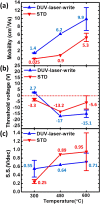Deep ultraviolet laser direct write for patterning sol-gel InGaZnO semiconducting micro/nanowires and improving field-effect mobility
- PMID: 26014902
- PMCID: PMC4444848
- DOI: 10.1038/srep10490
Deep ultraviolet laser direct write for patterning sol-gel InGaZnO semiconducting micro/nanowires and improving field-effect mobility
Abstract
Deep-UV (DUV) laser was used to directly write indium-gallium-zinc-oxide (IGZO) precursor solution and form micro and nanoscale patterns. The directional DUV laser beam avoids the substrate heating and suppresses the diffraction effect. A IGZO precursor solution was also developed to fulfill the requirements for direct photopatterning and for achieving semi-conducting properties with thermal annealing at moderate temperature. The DUV-induced crosslinking of the starting material allows direct write of semi-conducting channels in thin-film transistors but also it improves the field-effect mobility and surface roughness. Material analysis has been carried out by XPS, FTIR, spectroscopic ellipsometry and AFM and the effect of DUV on the final material structure is discussed. The DUV irradiation step results in photolysis and a partial condensation of the inorganic network that freezes the sol-gel layer in a homogeneous distribution, lowering possibilities of thermally induced reorganization at the atomic scale. Laser irradiation allows high-resolution photopatterning and high-enough field-effect mobility, which enables the easy fabrication of oxide nanowires for applications in solar cell, display, flexible electronics, and biomedical sensors.
Figures





Similar articles
-
Intense Pulsed Light Annealing Process of Indium-Gallium-Zinc-Oxide Semiconductors via Flash White Light Combined with Deep-UV and Near-Infrared Drying for High-Performance Thin-Film Transistors.ACS Appl Mater Interfaces. 2019 Apr 10;11(14):13380-13388. doi: 10.1021/acsami.8b22458. Epub 2019 Mar 27. ACS Appl Mater Interfaces. 2019. PMID: 30882197
-
Direct ArF laser photopatterning of metal oxide nanostructures prepared by the sol-gel route.Nanotechnology. 2010 Feb 10;21(6):065303. doi: 10.1088/0957-4484/21/6/065303. Epub 2010 Jan 8. Nanotechnology. 2010. PMID: 20057037
-
Highly effective field-effect mobility amorphous InGaZnO TFT mediated by directional silver nanowire arrays.ACS Appl Mater Interfaces. 2015 Jan 14;7(1):232-40. doi: 10.1021/am5059316. Epub 2014 Dec 26. ACS Appl Mater Interfaces. 2015. PMID: 25485556
-
Solution-Based Micro- and Nanoscale Metal Oxide Structures Formed by Direct Patterning for Electro-Optical Applications.Adv Mater. 2018 Dec;30(50):e1800923. doi: 10.1002/adma.201800923. Epub 2018 Aug 2. Adv Mater. 2018. PMID: 30073719 Review.
-
Precursor Design Strategies for the Low-Temperature Synthesis of Functional Oxides: It's All in the Chemistry.Chemistry. 2020 Jul 27;26(42):9070-9083. doi: 10.1002/chem.201905819. Epub 2020 Apr 17. Chemistry. 2020. PMID: 32026520 Review.
Cited by
-
Facile fabrication of wire-type indium gallium zinc oxide thin-film transistors applicable to ultrasensitive flexible sensors.Sci Rep. 2018 Apr 3;8(1):5546. doi: 10.1038/s41598-018-23892-4. Sci Rep. 2018. PMID: 29615757 Free PMC article.
-
Enhancement of electrical characteristics and stability of self-patterned In-Zn-O thin-film transistors based on photosensitive precursors.Sci Rep. 2020 Nov 2;10(1):18853. doi: 10.1038/s41598-020-76080-8. Sci Rep. 2020. PMID: 33139796 Free PMC article.
-
Selective Gelation Patterning of Solution-Processed Indium Zinc Oxide Films via Photochemical Treatments.Nanomaterials (Basel). 2025 Jul 24;15(15):1147. doi: 10.3390/nano15151147. Nanomaterials (Basel). 2025. PMID: 40801687 Free PMC article.
-
Design methodology for a confocal imaging system using an objective microlens array with an increased working distance.Sci Rep. 2016 Sep 12;6:33278. doi: 10.1038/srep33278. Sci Rep. 2016. PMID: 27615370 Free PMC article.
-
Recent Advances in Patterning Strategies for Full-Color Perovskite Light-Emitting Diodes.Nanomicro Lett. 2023 Dec 7;16(1):45. doi: 10.1007/s40820-023-01254-8. Nanomicro Lett. 2023. PMID: 38060071 Free PMC article. Review.
References
-
- Nomura K. et al. Room-temperature fabrication of transparent flexible thin-film transistors using amorphous oxide semiconductors. Nature 432, 488–492 (2004). - PubMed
-
- Kim M. G., Kanatzidis M. G., Facchetti A. & Marks T. J. Low-temperature fabrication of high-performance metal oxide thin-film electronics via combustion processing. Nature Mater. 10, 382–388 (2011). - PubMed
-
- Liu G. X. et al. High-performance fully amorphous bilayer metal-oxide thin film transistors using ultra-thin solution-processed ZrOx dielectric. Appl. Phys. Lett. 105, 113509 (2014).
-
- Chiang H. Q., Wager J. F., Hoffman R. L., Jeong J. & Keszler D. A. High mobility transparent thin-film transistors with amorphous zinc tin oxide channel layer. Appl. Phys. Lett. 86, 013503 (2005).
-
- Banger K. K. et al. Low-temperature, high-performance solution-processed metal oxide thin-film transistors formed by a ‘sol–gel on chip’ process. Nature Mater. 10, 45–50 (2011). - PubMed
Publication types
LinkOut - more resources
Full Text Sources
Other Literature Sources
Miscellaneous

